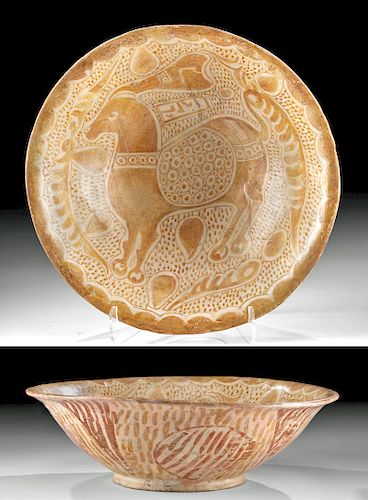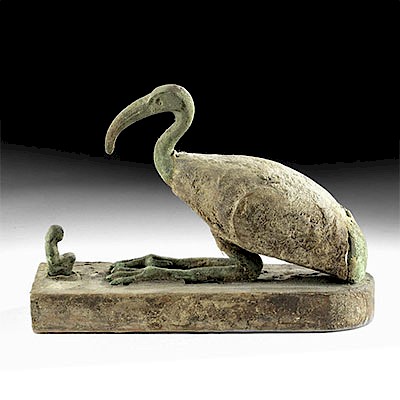Abbasid Lustreware Pottery Bowl with Ibex Motif
Lot 116
About Seller
Artemis Gallery
686 S Taylor Ave, Ste 106
Louisville, CO 80027
United States
Selling antiquities, ancient and ethnographic art online since 1993, Artemis Gallery specializes in Classical Antiquities (Egyptian, Greek, Roman, Near Eastern), Asian, Pre-Columbian, African / Tribal / Oceanographic art. Our extensive inventory includes pottery, stone, metal, wood, glass and textil...Read more
Estimate:
$10,000 - $15,000
Absentee vs Live bid
Two ways to bid:
- Leave a max absentee bid and the platform will bid on your behalf up to your maximum bid during the live auction.
- Bid live during the auction and your bids will be submitted real-time to the auctioneer.
Bid Increments
| Price | Bid Increment |
|---|---|
| $0 | $25 |
| $300 | $50 |
| $1,000 | $100 |
| $2,000 | $250 |
| $5,000 | $500 |
| $10,000 | $1,000 |
| $20,000 | $2,500 |
| $50,000 | $5,000 |
| $100,000 | $10,000 |
| $200,000 | $20,000 |
About Auction
By Artemis Gallery
Oct 31, 2019
Set Reminder
2019-10-31 10:00:00
2019-10-31 10:00:00
America/New_York
Bidsquare
Bidsquare : Fine Antiquities, Asian, Ethnographic Art
https://www.bidsquare.com/auctions/artemis-gallery/fine-antiquities-asian-ethnographic-art-4581
Our Halloween Day auction features classical antiquities, ancient and ethnographic art from cultures encompassing the globe, plus fine art. Artemis Gallery info@artemisgallery.com
Our Halloween Day auction features classical antiquities, ancient and ethnographic art from cultures encompassing the globe, plus fine art. Artemis Gallery info@artemisgallery.com
- Lot Description
Near East/Middle East, Iraq, Abbasid Dynasty, ca. 9th to 10th century CE. A magnificent lustreware (lusterware) ceramic bowl, made in ancient Iraq, its technology inspired by Tang China. It is a shallow bowl with wide, flaring sides and a diminutive disc foot. The interior and exterior are decorated with beautiful motifs. The exterior features golden-colored and copper-colored lines and circles in a complex geometric pattern. The interior features a fanciful ibex or possibly a horse with either a huge pair of antlers or a mane rising from the back of the head. Its body is thick, its tail a series of spirals, and it wears a decorative ribbon and saddle. Opposite its tail is another spiral-like motif - this one Kufic script, painted in a single thick, steady stroke to create a line of highly stylized letters. A shorter line of text is below the animal's body. Surrounding the motifs is a dense background of dots as if the animal is traversing a rainy landscape. Size: 11.25" W x 3.25" H (28.6 cm x 8.3 cm)
In the later 8th century, Islamic empires in the west and China in the east battled each other for control of the incredibly lucrative trade along the Silk Road. At one point, the western powers captured a group of Tang Dynasty craftsmen, holding them in Baghdad for over 10 years. Tou-Houan, one of these captives, had been taken from his workshop near Samarqand during the Battle of Talas in 751 CE. After his return to China over a decade later, he wrote to his emperor that he and his countrymen had taught the Abbasids several important techniques. With this knowledge, Abbasid artisans created lustreware, a decorative style that they likened to alchemy - it used a lead-based glaze, silver, and copper paint to create a golden sheen on ceramic surfaces. The warm glow of the motifs here are a perfect example of this "magical" technology.
See several similar examples in the Khalili Collection, London, UK, the most famous collection of Islamic artwork in the world; see a similarly colored example at the Metropolitan Museum of Art (40.170.27).
Provenance: private California, USA collection
All items legal to buy/sell under U.S. Statute covering cultural patrimony Code 2600, CHAPTER 14, and are guaranteed to be as described or your money back.
A Certificate of Authenticity will accompany all winning bids.
We ship worldwide and handle all shipping in-house for your convenience.
#149147Expertly repaired and restored from multiple pieces with very limited overpainting along some of the repair lines. Otherwise all pigment is original. Motifs are wonderfully preserved. Foot has some small losses but the bowl stands easily on its own.Condition
- Shipping Info
-
All shipping is handled in-house for your convenience. Your invoice from Artemis Gallery will include shipping calculation instructions. If in doubt, please inquire BEFORE bidding for estimated shipping costs for individual items.
-
- Buyer's Premium



 EUR
EUR CAD
CAD AUD
AUD GBP
GBP MXN
MXN HKD
HKD CNY
CNY MYR
MYR SEK
SEK SGD
SGD CHF
CHF THB
THB
















